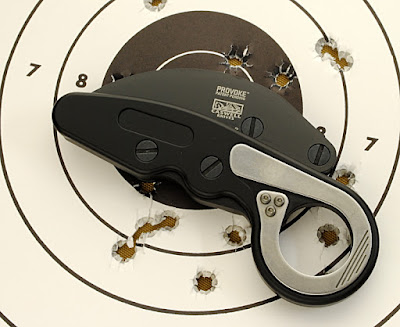Imagine a holster company designing
a holster and not having a gun to fit.
Improbable? Maybe not. What if the company wants to start competing
in a new area but needs something to fit it.
Stoner Holster contacted one of
my favorite knife companies, Shadow Tech, with a request, “Can you build us a
knife to fit this sick leather sheath we want to make?”
The answer appears to be yes!
 |
| My first look at the Trail Blazer |
I saw the prototype; ST calls it the
Trail Blazer. It’s mega cool.
The saber grind blade is 5.75
inches long and a quarter inch thick at the spine and sports aggressive
cross-cut saw teeth. The full tang
handle is also 5.75 inches long and features Micarta grips providing a solid
and substantial grip.
The blade is 8670 steel used in
the lumber industry for large circular saws because of its toughness and edge
retention abilities. The blade has a 60
Rc hardness. The blade isn’t stainless
and the powder coating helps protect the blade.
You have to do your part with a little oil on the exposed metal.
 |
| Those are some aggressive saw teeth! |
The leather sheath can be adapted
for a tactical molle system, or different width belts. The sheath contains a small pocket and a loop
for a fire starting ferro stick. The one
I got to see had a small diode light and a permanent match.
 |
| Back of Sheith showing arrangement. Note the diode light. |
This is a prototype so expect
changes. I understand Dot Snaps will replace
the current ones to give the sheath more reliability. John tells me the grip will change slightly
with a slight swelling to help grip the knife.
I don’t know if the leather and
micarta will stay these colors or if options will be available. I also don’t know how the blade cuts or will resharpen. Will the handle fit my hand or will hotspots
develop after a couple hours of work needs to be answered later. I would not be surprised if the dimensions
change a little in length. Again, this
is a prototype.
I would have liked to seen a
small sharpening stone. 8670 steel may
have great edge retention, but all steel loss sharpness during use.
Still this is a very cool knife
and it will be available in May. Hey,
that’s next month, so if you want one, you better preorder now or expect you’ll
have to wait later on.
Go to http://www.stknives.com/ to order your own
Shadow Tech Trail Blazer. While you're there take a look at some of the other knives they have. You can also call them at 614-648-1297.































